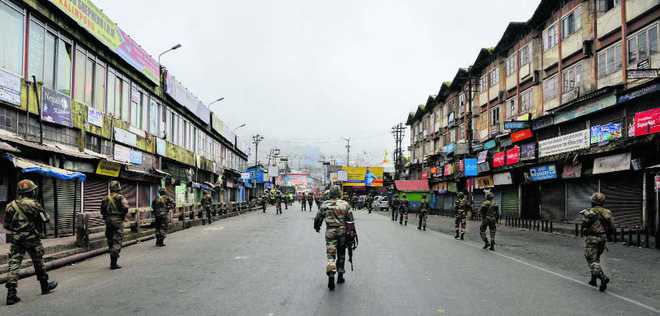
DISCONTENT BREWING: Soldiers patrol a street after clashes with supporters of the Gorkha Janmukti Morcha (GJM) group in Darjeeling. File picture: AFP
Shubhadeep Choudhury in Kolkata
In violence-affected Darjeeling and Kalimpong in West Benngal, there is much more than strident voices of a separate state of Gorkhaland. An academic exercise about the idea of a separate state is silhouetted against the more impending arrangements for keeping law and order. The Gorkha Janmukti Morcha (GJM) championing the cause of Nepali-speaking people and spearheading the stir is aggressive, though, it is aware that politically, its demand is a long haul. Several things apart, if Gorkhaland were to be a reality, it would be the second Nepali-speaking people’s majority state after Sikkim.
Whose land, whose territory?
After the semi-autonomous Gorkhaland Territorial Administration (GTA) was formed in 2011, Bimal Gurung, GJM chief, had remarked that GTA would pave the way for a separate state. Bodoland Autonomous Council (BAC) in Assam, too, would become a separate state one day, Gurung had stated. He asked: Wasn’t Nagaland, which formed a part of Assam but enjoyed autonomy, already a separate state?
Nagaland, Bodoland, Gorkhaland -- there is a striking similarity in the names. A huge difference though separates the first two from the last. Nagas and Bodos are sons of the soil. Gorkhas (a nomenclature chosen by the agitators to distinguish themselves from the inhabitants of Nepal), on the other hand, are immigrants. They came to the area following the footsteps of the British and outnumbered the local population consisting of the Bhutias and Lepchas.
The British legacy
“With the advent of the British (1861), the demographic composition of Sikkim underwent a rapid change. Nepali settlers soon outnumbered the Bhutia-Lepcha combination of the population in Sikkim,” says Anjan Chakravarti, faculty member at the University of Burdwan.
Pulls and pressures worked thereafter. “The rise of Prithvi Narayan Shah in Nepal forced the lower-caste small peasants and artisans to leave Nepal. At the same time, recruitment in the British army and demand for cheap labour for carrying out British-led construction works in Sikkim forced the poor Nepalese to leave Nepal and settle in Sikkim with active British encouragement”, says Chakravarti.
Nepalese settlers in Sikkim were denied right over land. This, coupled with the fact that the settlers were Hindus while the Bhutias and Lepchas were Buddhists, became a source of considerable tension.
The Nepali settlers launched a series of movements culminating in Sikkim becoming a part of India in 1974 as the 22nd state. Monarchy in Sikkim gave way for democracy. The Nepalese, by virtue of being in majority, captured power.
“The decision to choose India over native Nepal for integration of Sikkim also speaks volumes about the quality of the Nepalese leadership of Sikkim,” says Bani Prasanna Misra, former director of the Centre for Himalayan Studies at Siliguri’s North Bengal University.
“Political instability and economic insecurity drove the Nepalese out of their country for generations to fan out across the Terai and Dooars and occupy large tracts of Sikkim and Bhutan, resulting in upheavals of one kind or another in both places. This migration gained additional impetus under official auspices after the British acquired Darjeeling,” says political analyst Sunanda K Datta Ray.
A parallel with Tripura?
It is tempting to draw a parallel between Gorkhaland and Tripura and argue that in Tripura, too, the original inhabitants have got sidelined. Outsiders (Bengalis) dominate the political scene.
However, Anjan Chakravarty, who earlier taught in Darjeeling’s St Joseph’s College, disagrees. He says Tripura had become a Bengali-majority area long before Independence when there was no legal basis for regarding the Bengali-speaking people of East Bengal (who comprise the majority of the Bengali speaking people of Tripura) as foreigners.
“But Nepal has always been a foreign country”, Chakravarti points out.
If the Gorkhaland demand is conceded, it will amount to handing over political power to settlers ignoring the traditional inhabitants. It is not surprising that Lyangsong Tamsang Lepcha, chairman of the Lepcha Development Board, has agreed to become chairperson of the committee set up by West Bengal Chief Minister Mamata Banerjee for challenging the GJM in the hills.
Sikkim, Gorkhaland and the independent country of Nepal form a contiguous territory. All those who long for “Greater Nepal” must be watching with interest the progress of the ongoing agitation. “Greater Nepal”, which spreads from the Sutlej in the west to Teesta in the east, is a live concept with a strong fan following. Check it on the google, it produces over two crore results!
Nepali migrants are now spread over a much larger area than the territory unified by the 18th century king Prithvi Narayan Shah. The Tezpur Lok Sabha seat of Assam and Kangpokpi assembly constituency of Manipur are controlled by Nepali speakers. They are present in Bhutan in huge numbers.
Harka Bahadur Chhetri of the Jan Andolon Party (JAP), a breakaway faction of GJM, however, argues that Gorkhaland poses no such threat. “It will give a sense of identity to the Indian Gorkhas. A Gorkha from any part of India can come and settle there,” says Chhetri.



























